
The persimmon is the edible fruit of a number of species of trees in the genus Diospyros. The most widely cultivated of these is the kaki persimmon, Diospyros kaki – Diospyros is in the family Ebenaceae, and a number of non-persimmon species of the genus are grown for ebony timber. In 2019, China produced 75% of the world total of persimmons.
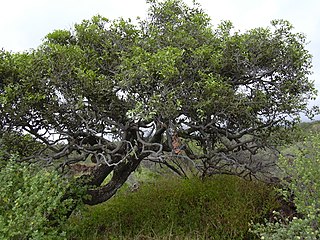
The Ebenaceae are a family of flowering plants belonging to order Ericales. The family includes ebony and persimmon among about 768 species of trees and shrubs. It is distributed across the tropical and warmer temperate regions of the world. It is most diverse in the rainforests of Malesia, India, tropical Africa and tropical America.
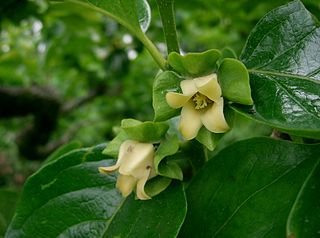
Diospyros is a genus of over 700 species of deciduous and evergreen trees and shrubs. The majority are native to the tropics, with only a few species extending into temperate regions. Individual species valued for their hard, heavy, dark timber, are commonly known as ebony trees, while others are valued for their fruit and known as persimmon trees. Some are useful as ornamentals and many are of local ecological importance. Species of this genus are generally dioecious, with separate male and female plants.

Colophospermum mopane, commonly called mopane, mopani, balsam tree, butterfly tree, or turpentine tree, is a tree in the legume family (Fabaceae), that grows in hot, dry, low-lying areas, 200 to 1,150 metres in elevation, in the far northern parts of Southern Africa. The tree only occurs in Africa and is the only species in genus Colophospermum. Its distinctive butterfly-shaped (bifoliate) leaf and thin seed pod make it easy to identify. In terms of human use it is, together with camel thorn and leadwood, one of the three regionally important firewood trees.

Diospyros virginiana is a persimmon species commonly called the American persimmon, common persimmon, eastern persimmon, simmon, possumwood, possum apples, or sugar plum. It ranges from southern Connecticut to Florida, and west to Texas, Louisiana, Oklahoma, Kansas, and Iowa. The tree grows wild but has been cultivated for its fruit and wood since prehistoric times by Native Americans.

Syzygium cumini, commonly known as Malabar plum, Java plum, black plum, jamun, jaman, jambul, or jambolan, is an evergreen tropical tree in the flowering plant family Myrtaceae, and favored for its fruit, timber, and ornamental value. It is native to the Indian subcontinent and Southeast Asia, including Myanmar, Sri Lanka, Bangladesh and the Andaman Islands. It can reach heights of up to 30 metres (98 ft) and can live more than 100 years. A rapidly growing plant, it is considered an invasive species in many world regions.
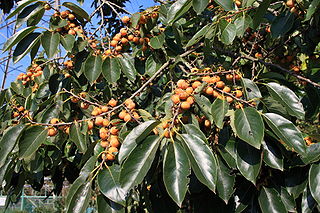
Diospyros lotus, with common names date-plum,Caucasian persimmon, or lilac persimmon, is a widely cultivated species of the genus Diospyros, native to temperate Asia and southeast Europe. Its English name derives from the small fruit, which have a taste reminiscent of both plums and dates. It is among the oldest plants in cultivation.

Diospyros blancoi,, commonly known as velvet apple, velvet persimmon, kamagong, or mabolo tree, is a tree of the genus Diospyros of ebony trees and persimmons. It produces edible fruit with a fine, velvety, reddish-brown fur-like covering. The fruit has a soft, creamy, pink flesh, with a taste and aroma comparable to peaches.
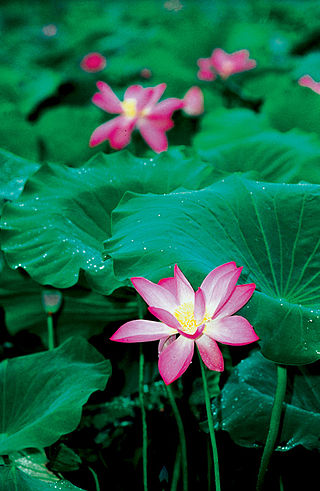
This is a list of plants commonly found in Kakadu National Park, Northern Territory of Australia. Where known, common names are given in English and in Gun-djeihmi, a commonly spoken indigenous language in the area, are given in parentheses.

Punica protopunica, commonly known as the pomegranate tree or Socotran pomegranate, is a species of flowering plant in the family Lythraceae. It is endemic to the island of Socotra (Yemen). Its natural habitat is subtropical or tropical dry forests.

Ziziphus mucronata, known as the buffalo thorn, is a species of tree in the family Rhamnaceae, native to southern Africa. It is deciduous and may grow up to 17 metres tall. It can survive in a variety of soil types, occurring in many habitats, mostly open woodlands, often on soils deposited by rivers, and grows frequently on termite mounds. Its Zulu name “umLahlankosi” alludes to its use as a grave marker for tribal chiefs, while the Afrikaans name “Blinkblaar-wag-'n-bietjie” alludes to the shiny light green leaves and the hooked thorns.

Diospyros pentamera is a common rainforest tree in the Ebony or Persimmon family (Ebenaceae) growing from near Batemans Bay in New South Wales to the Atherton Tableland in tropical Queensland, Australia. It is commonly known as the myrtle ebony, black myrtle, grey plum or grey persimmon.
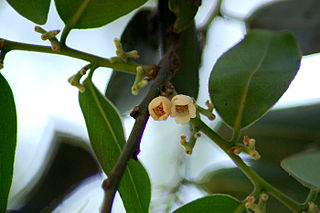
Diospyros malabarica, the gaub tree, Malabar ebony, black-and-white ebony or pale moon ebony, is a species of flowering tree in the family Ebenaceae that is native to the Indian Subcontinent and South East Asia.
Diospyros abyssinica is a tree species in the family Ebenaceae which is native to Sub-Saharan Africa.
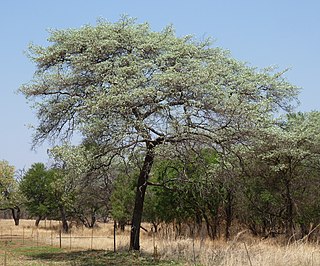
Terminalia sericea is a species of deciduous tree of the genus Terminalia that is native to southern Africa. Its common names include clusterleaf, silver cluster-leaf or silver terminalia in English, vaalboom in Afrikaans and mususu in Venda.
Commiphora africana, commonly called African myrrh, is a small deciduous tree belonging to the Burseraceae, a family akin to the Anacardiaceae, occurring widely over sub-Saharan Africa in Angola, Botswana, Burkina Faso, Chad, Eswatini, Eritrea, Ethiopia, Kenya, Mali, Mauritania, Mozambique, Namibia, Niger, Senegal, Somalia, South Africa, Sudan, Tanzania, Uganda, Zambia and Zimbabwe. On sandy soils this species sometimes forms pure stands, deserving consideration as a plant community or association.

Diospyros dichrophylla (Gand.) De Winter is a Southern African tree belonging to the ebony family of Ebenaceae and closely related to the Persimmon.

Ximenia caffra, the sourplum, is a small tree or small shrub that is thinly branched. It is part of the Olacaceae family which is native throughout tropical regions. In particular, the sourplum is native to regions in South East Africa, mainly Botswana, Kenya, Malawi, Mozambique, South Africa, Tanzania, Uganda, Zambia, and Zimbabwe. The sourplum tree produces several fruits on an annual basis. These are generally sour with a dry aftertaste, and they contain significant amounts of potassium. The tree itself is fairly hardy, with frost resistance and drought tolerance. The tree, fruit, seed, leaves, and roots are all used for human consumption, medicinally, or for fuel. The trees themselves can also be used as natural land division barriers.

Diospyros revaughanii is a rare species of tree in the family Ebenaceae (ebony).
Balanites rotundifolia, known in Swahili as Mbamba ngoma is a spiny bush or small tree from eastern Africa and southern Arabia. It is a member of the caltrop family, Zygophyllaceae.























